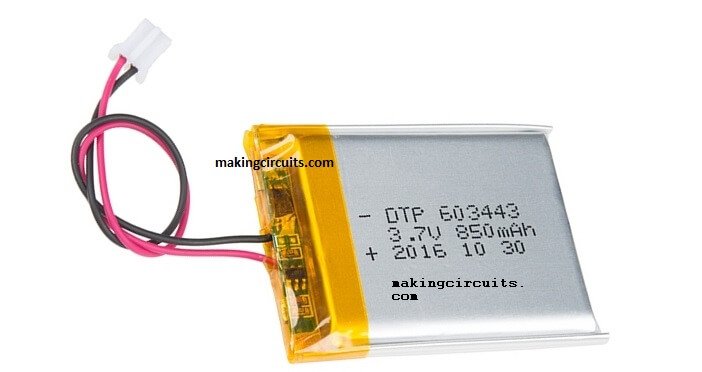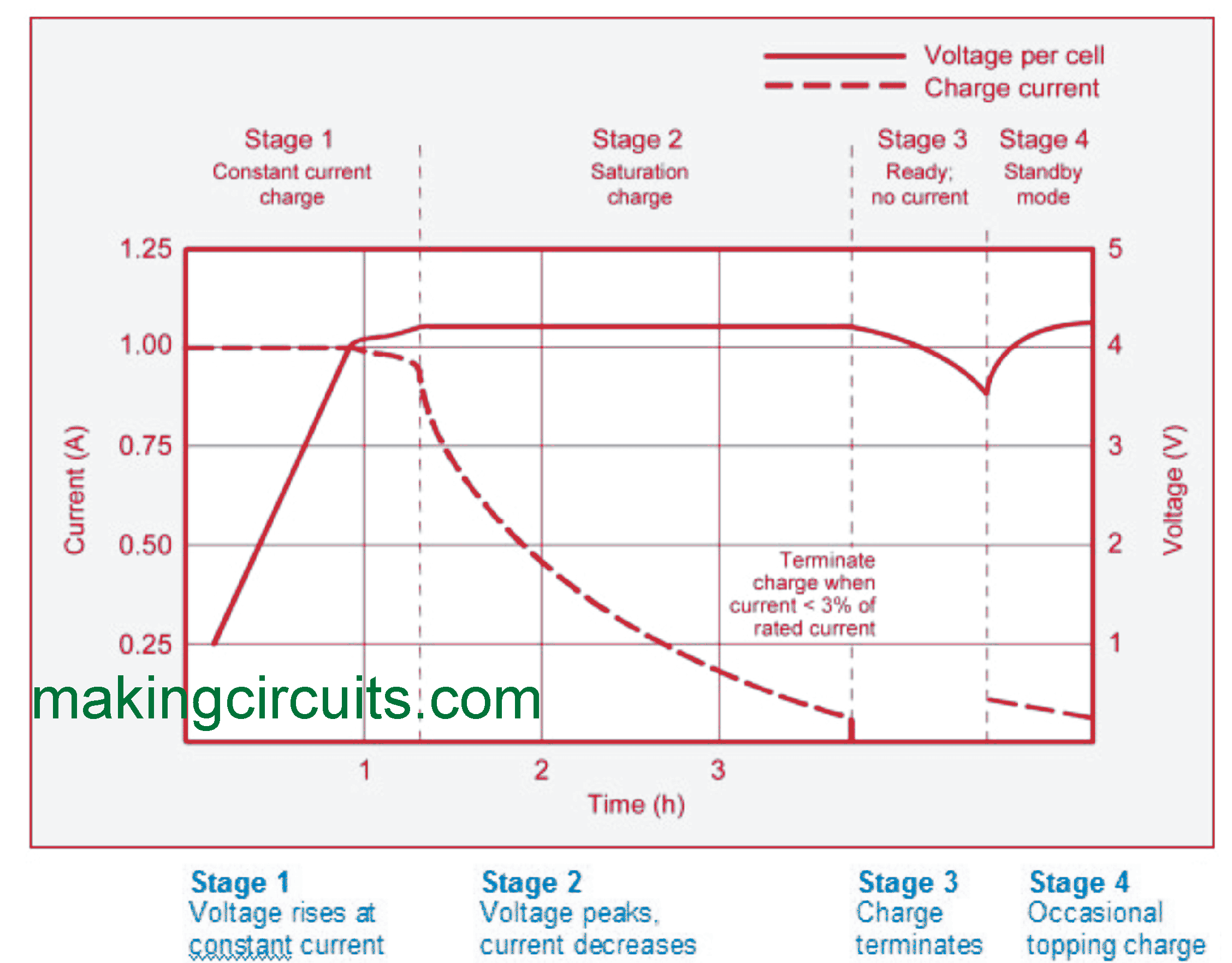The post details the correct method of charging a Li-Ion battery with safe parameters. Let's learn the main points below:
The recommended charging rate of an Li-Ion Cell is between 0.5C and 1C; the full charge period is approximately TWO TO THREE hours.

In "1C", "C" refers to the AH or the mAH value of the battery, meaning if the Li-ion cell is rated at 2600mAH then the "C" value becomes 2600, or 2.6 Amps, which implies that it can be charged at its full 1C, or at 2.6 amps if required.
Companies of these cells encourage charging with 0.8C or less in order to lengthen battery life; on the other hand, many Power Cells will acquire an increased charge C-rate using minor stress.
Charge performance is approximately 99 percent and the cell continues to be cool in the course of charging process.
A number of Li-ion batts may possibly encounter a temperature surge of approximately 5ºC (9ºF) while achieving 100 % charge. This might be as a result of protection circuit and raised internal resistance.
You should stop making use of the battery or charger in case the temperature goes up over 10ºC (18ºF) within reasonable charging rates.
Full charge takes place when the battery extends to the voltage limit and the current drops to three percent of the rated current.
A battery can also be regarded as completely charged when the current comes to the same level and unable to drop any more. Increased self-discharge could possibly be the reason for this disorder.
Boosting the charge current is not going to speed up the full-charge status enough, apparently. Despite the fact that the battery gets to the optimum voltage more rapidly, the saturation charge normally takes longer time consequently.

Referring to the above graph, with increased current, Stage 1 is quicker however the saturation throughout Stage 2 is going to take more time. A higher current charge may, however, rapidly fill up the battery to around 70%.
Li-ion will not have to be totally charged as is the situation with lead acid, neither is it advisable to accomplish this. Actually, it is far better never to thoroughly charge just because a high voltage strains the battery.
Deciding on a lower voltage tolerance or getting rid of the saturation charge completely, extends battery life although that lowers the back up time slightly.
Chargers for client goods choose optimum capacity and can't be modified; lengthened product lifespan is identified a lot less essential.
Some lower-cost commercial chargers could use the simple “charge-and-run” approach that will charge a lithium-ion battery in an hour or less without exploring Stage 2 saturation charge.
“All set” shows up when the battery gets to the full voltage limit at Stage 1. State-of-charge (SoC) at this stage is around 85 percent, an amount that could be adequate for several customers.
Some alternative chargers set a lower charge voltage limit deliberately to extend battery-life.
Charge V/cell | Capacity at | Charge time | Capacity with full saturation |
3.80 3.90 4.00 4.10 4.20 | 60% 70% 75% 80% 85% | 120 min 135 min 150 min 165 min 180 min | ~65% ~75% ~80% ~90% 100% |
The table shown above demonstrates the approximated volumes when charged to various voltage thresholds by using and with no saturation charge. (See also BU-808: How to Prolong Lithium-based Batteries.)
Li-ion batteries are not able to take in overcharge. Whenever completely charged, the charge current has to be shut down. A consistent drip charge might result in plating of metallic lithium and skimp on safety. To reduce strain, maintain the lithium-ion battery on the peak cut-off as brief as you can.
As soon as the charge is ended, the battery voltage starts to decline. This assists in easing the voltage stress. With time, the open circuit voltage will probably negotiate to between 3.70V and 3.90V/cell.
Remember that a Li-ion battery which has acquired a completely saturated charge keeps the voltage higher for a extended than one which hasn't attained a saturation charge.
Whenever lithium-ion batteries has to be kept in the charger for functional ability, some chargers implement a short filling charge to pay for the little self-discharge the battery and its shielding circuit take in.
The charger might get started once the open circuit voltage falls to 4.05V/cell and switch off yet again at 4.20V/cell.
Chargers designed for functional preparedness, or standby mode, frequently allow the battery voltage drop to 4.00V/cell and recharge to solely 4.05V/cell rather than the total 4.20V/cell. This minimizes voltage-related stress and extends battery-life.
A few lightweight equipment hold charge during the ON situation. The current consumed with the unit is known as the parasitic load and this can corrupt the charge cycle.
Battery companies recommend against such parasitic loads during the charging process, since they lead to mini-cycles. This cannot continually be prevented and a laptop attached to the AC mains is such an instance.
The battery could possibly be charged to 4.20V/cell after which discharged through the unit. The stress level on the battery can be excessive since the cycles take place on the high-voltage limit, and often also at raised temperature.
A portable unit must be switched off in the course of charge. This permits the battery to attain the established voltage limit, and current saturation point flawlessly.
A parasitic load rattles the charger by suppressing the battery voltage, and blocking the current within the saturation phase to decrease to a point low enough by simply pulling a leakage current.
A battery could be completely charged, however the predominant circumstances may force a extended charge, triggering more stress.
Let's Summarize Quickly, the main Points regarding How to Charge a Li-Ion Battery Safely and Correctly
- Switch off the unit or detach the load while charging to let the current to decrease unhindered in the course of saturation. This is required because a parasitic load could "confuse" the charger.
- Always charge with a modest temperature. Never charge at freezing temperature.
- Lithium-ion truly does not have to be fully charged; a partial charge is the most suitable.
- Not every chargers implement a complete topping charge as well as battery most likely will not be fully charged once the “ready” sign shows up; a 100 % charge over a fuel gauge could be a false signal.
- You should stop using the charger and/or battery in the event the battery starts becoming too much warm.
- Put on some charge to a discharged battery prior to retaining (40-50 percent SoC is more preferable).

johannes@king.ma says
Too much warm?